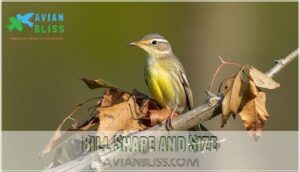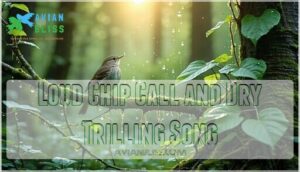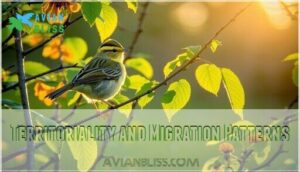This site is supported by our readers. We may earn a commission, at no cost to you, if you purchase through links.
 You’ll recognize the worm eating warbler by its bold black and buff striped head – like racing stripes painted across its flat crown.
You’ll recognize the worm eating warbler by its bold black and buff striped head – like racing stripes painted across its flat crown.
This sparrow-sized songbird measures 4.4-5.2 inches with brownish-olive upperparts and buffy underparts that blend perfectly with fallen leaves.
Despite its name, it doesn’t actually eat worms but hunts insects and spiders using its specialized spike-like bill to probe dead leaf clusters.
You’ll find these secretive birds in mature deciduous forests with dense understories, particularly on steep hillsides across eastern North America.
Their distinctive loud "chip" call and rapid, dry trill echo through the forest during breeding season.
What makes their foraging technique so remarkably effective goes beyond just that specialized bill design.
Table Of Contents
- Key Takeaways
- Identifying The Worm-eating Warbler
- Habitat and Geographic Range
- Behavior and Foraging Habits
- Breeding and Nesting Patterns
- Conservation and Interesting Facts
- Frequently Asked Questions (FAQs)
- Are worm-eating warblers rare?
- Where can I find worm-eating warblers?
- What is similar to a worm-eating warbler?
- What is the difference between worm-eating and chipping sparrow?
- How does climate change impact this species?
- Are there any conservation efforts in place to protect them?
- What are some unique characteristics of their song?
- Where can I find more info and resources about this bird?
- What foods attract worm-eating warblers to feeders?
- How do climate changes affect their population numbers?
- Conclusion
Key Takeaways
- You’ll identify worm-eating warblers by their bold black and buff striped heads and brownish-olive bodies, despite their misleading name since they actually hunt insects and spiders, not worms.
- You’ll find these secretive birds in mature deciduous forests with dense understories on steep hillsides across eastern North America, where they require large forest tracts exceeding 40 hectares.
- You’ll recognize their distinctive loud "chip" call and rapid, dry trill that sounds more like insect buzzing, helping you locate these ground-foraging birds in thick vegetation.
- You’ll need to support conservation efforts since habitat loss and forest fragmentation threaten their populations, even though they play crucial roles in controlling pest insects and maintaining forest ecosystem health.
Identifying The Worm-eating Warbler
You’ll identify the Worm-eating Warbler by its distinctive flat head marked with bold black and buff stripes running from the bill through the eye and across the crown.
The distinctive flat-headed warbler with bold black crown stripes—an unmistakable forest jewel hiding in plain sight
This sparrow-sized bird displays brownish-olive upperparts with buffy underparts, a long spike-like bill, and pale legs that help distinguish it from similar warbler species.
Physical Characteristics
You’ll easily recognize this worm eating warbler by its distinctive features among small bird species.
The warbler characteristics include specific measurements and markings that set it apart from other bird ecology specimens.
Physical identification markers:
- Body Size – Measures 4.4-5.2 inches long with 0.4-0.5 ounce weight
- Bill Shape – Long, spike-like structure adapted for probing
- Feather Color – Olive-buff tones throughout body plumage
- Wing Structure – Moderately long wings spanning 7.9-8.7 inches
Flat Head and Black Stripes
You’ll notice the worm eating warbler’s distinctively flat head shape immediately sets it apart from other warbler species.
Bold black crown stripes run along the head’s center and sides, creating striking facial markings that contrast sharply with buff-colored areas.
These distinctive stripe patterns make warbler identification straightforward, as the crown features remain consistent across both males and females of this small bird species throughout the year, with bold black stripes being a key identifier, and the overall appearance making it easy to recognize the warbler species.
Brownish Olive Body
You’ll recognize the Worm-eating Warbler’s distinctive brownish olive body coloration that sets it apart from other warblers during warbler migration seasons.
This muted olive-brown plumage variation provides excellent camouflage among dead leaves where these insectivorous birds forage.
The feather texture appears soft and unreflective, while their compact body size makes warbler identification challenging without proper observation of these subtle color patterns.
Pale Legs and Short Tail
The Worm-eating Warbler’s Leg Color appears pale pinkish or flesh-colored, contrasting with its olive-brown plumage.
Its Tail Length remains relatively short compared to other warblers, creating a compact silhouette.
The Tail Feathers display subtle brown tones that complement the bird’s overall coloration, while the sturdy Leg Structure supports its ground-foraging lifestyle.
- Pale pinkish legs distinguish it from darker-legged insectivorous birds
- Short tail creates a stocky appearance during warbler migration
- Feather Texture on tail appears smooth and well-maintained
- Leg and tail proportions reflect specialized worm eating habits and warbler behavior
Bill Shape and Size
You’ll identify a worm-eating warbler by its distinctive bill length and spike-like beak shape.
This specialized jaw structure extends roughly half an inch with sharp spike tips, perfectly designed for probing dead leaf clusters.
The mouth size appears proportionally large compared to other warblers, supporting their worm-based diet and insect-hunting behavior.
Bird watching enthusiasts often mistake this feature for typical warbler songs adaptations, but it’s actually specialized for their unique worm eating habits rather than standard avian diet preferences, highlighting the importance of understanding the bird’s unique worm eating behavior.
Comparison With Similar Species
Several warbler species share similar features with the Worm-eating Warbler, making Species Comparison essential for accurate Warbler Identification.
Swainson’s Warbler presents the closest match, sporting a rusty-brown cap instead of black crown stripes and brown eye stripes rather than black ones. Tennessee Warblers lack distinctive head striping entirely.
Orange-crowned Warblers show subtle orange patches and different Beak Structure. During Bird Similarities analysis, focus on head patterns—the Worm-eating Warbler’s bold black stripes on buff background remain unique among eastern warbler species in dense warbler habitats.
Understanding habitat conservation efforts is paramount for protecting these species and their ecosystems, which is crucial for overall Warbler Identification and habitat conservation.
Habitat and Geographic Range
You’ll find Worm-eating Warblers in mature deciduous and mixed forests with dense understories, particularly on steep hillsides where rhododendron, laurel, and dogwood create thick cover.
In mature forests with thick understory, these secretive warblers find perfect cover among rhododendron and laurel
These birds require large forest tracts exceeding 40 hectares and breed across eastern North America from New England to the Gulf Coast before migrating to the Caribbean and Central America for winter.
They migrate to these areas for winter, making their breeding grounds and migration patterns interesting subjects for study.
Deciduous and Mixed Forests
You’ll discover these forest birds thriving in mature hardwood stands where beech, maple, oak, and hickory create the perfect canopy layers.
Forest ecology research shows warblers prefer closed-canopy environments that maintain moist understory plants essential for insect eating birds.
Bird conservation efforts focus on protecting these warbler habitats since forest floors beneath dense tree species support the arthropod populations these specialized forest birds require for survival.
Conservation of dense understory is vital for maintaining the warbler’s preferred habitat.
Dense Understory and Steep Hillsides
Traversing dense understory vegetation on steep terrain requires patience when searching for these secretive worm eating birds.
Forest slope environments with thick understory plants create ideal hunting grounds, where dense canopy coverage provides protection from predators.
These insect eating birds thrive in challenging steep terrain where hillside erosion creates diverse microhabitats. Warbler research consistently shows forest birds prefer these complex understory layers for both nesting and foraging activities.
Understanding bird habitats and ecosystems is vital for conservation efforts and preserving the natural balance of these environments.
Regional Distribution and Migration
These striking warblers span North America’s eastern regions, breeding from southeastern Nebraska to New England and wintering in Central America and the Caribbean.
Migration Patterns showcase remarkable precision as they navigate thousands of miles along established Flyway Routes.
Regional Distribution highlights:
- Breeding Grounds concentrate in Appalachian Mountains and southeastern uplands where mature forests thrive
- Wintering Areas extend from Mexico to Panama, supporting diverse populations in tropical lowlands
- Geographic Range expansion occurs in northeastern states due to forest recovery and warbler research initiatives
Spring migration begins in late March, with birds arriving at northern territories by mid-May, while fall departures peak in early September.
The warblers’ migration timing is influenced by spring migration patterns that shape their annual movements.
Large Forest Tracts and Closed-canopy Forests
You’ll find these warblers exclusively in large forest tracts exceeding 40 hectares with closed-canopy coverage.
Forest ecology research shows they avoid fragmented habitats, preferring continuous tree canopy that supports diverse understory plants.
Their worm-based diet requires rich forest floor conditions where earthworms and parasites thrive.
Habitat restoration efforts focus on maintaining these extensive woodland systems that support ideal bird diversity and healthy species populations throughout their breeding range, with an emphasis on healthy species.
Behavior and Foraging Habits
You’ll observe Worm-eating Warblers actively hunting insects and spiders by methodically probing through dead leaf clusters on the forest floor and in dense undergrowth.
Their distinctive loud "chip" call and rapid, dry trill help you locate these secretive birds as they maintain territories and follow predictable migration patterns between their breeding and wintering grounds, utilizing their distinctive abilities to thrive.
Insect-eating and Spider-hunting
You’ll observe worm-eating warblers employing specialized hunting tactics to capture insect prey throughout the forest understory.
These birds target arthropod diet components including spiders, caterpillars, and various parasites.
Their sharp, spike-like bills excel at extracting prey from spider webs and bark crevices.
Unlike species with worm based diet preferences or those consuming annelids, these warblers focus entirely on living arthropods, demonstrating remarkable bird diversity in foraging strategies.
The use of effective insect catching tools is essential for understanding their foraging behavior and insect catching techniques.
Foraging in Foliage and Dead Leaves
You’ll find these birds methodically searching through leaf litter and dead foliage with remarkable precision.
Their specialized foraging tactics target invertebrate prey hidden within the forest floor’s debris, though despite their name, they rarely consume actual earthworms or annelids.
Their habitat requirements shape their unique approach:
- Leaf Litter Investigation – Probing systematically through accumulated debris
- Foliage Search Patterns – Examining dead leaf clusters suspended in vegetation
- Forest Floor Exploration – Turning over organic matter to expose hidden arthropods
Understanding their behavior involves recognizing ground feeding behaviors that influence their foraging strategies.
Loud Chip Call and Dry Trilling Song
You’ll recognize this species by its distinctive vocal patterns and song structure.
The male’s call frequency includes a loud, sharp "chip" note that cuts through dense undergrowth where these birds hunt for worms and other invertebrates.
Their signature trill duration creates a flat, dry sound resembling insect buzzing – perfect for audio recognition in forest ecology.
This animal’s biology includes unique vocalizations that help establish territory within their preferred habitat.
Territoriality and Migration Patterns
Males defend territories averaging 4.3 acres through vigorous song displays and boundary patrols during breeding seasons.
These territorial behaviors intensify during courtship, with physical confrontations between competing males.
Migration routes span eastern North America, with nocturnal flights covering thousands of miles to wintering grounds in Central America and the Caribbean.
Unlike many species, they migrate solitarily rather than in flocking patterns, taking nocturnal flights and traveling to wintering grounds.
Breeding and Nesting Patterns
Worm-eating Warblers construct their nests directly on the forest floor, expertly camouflaged among fallen leaves and dense vegetation to avoid detection by predators.
The breeding season extends from late April through July, with females taking sole responsibility for the 13-day incubation period.
While both parents collaborate in feeding the young until they fledge approximately 10 days after hatching, this joint effort is crucial for the survival of the young.
Ground-dwelling Nest and Camouflage
Worm-eating Warblers construct their ground nests with remarkable stealth, turning the forest floor into their personal hideaway.
These birds master the art of disappearing in plain sight through strategic nest placement and natural camouflage techniques.
Their nesting behavior is influenced by the availability of suitable ground nest materials and structures.
Ground nesting camouflage strategies:
- Nest Placement – Built directly on the forest floor beneath dense shrubs or fallen logs
- Leaf Litter Integration – Woven seamlessly into existing dead leaves and organic debris
- Ground Cover Selection – Hidden under thick understory vegetation like rhododendron or laurel
- Natural Concealment – Positioned near tree bases where root systems create natural hiding spots
- Soil Camouflage – Nest materials blend with surrounding earth tones and forest textures
Their habitat choice eliminates competition with earthworms and other soil invertebrates for space, while the annelids remain undisturbed below.
Egg Laying and Incubation
Female Worm-eating Warblers typically lay 4-5 creamy eggs with reddish speckles during late April through May, forming one clutch per breeding cycle.
The incubation period spans 12-14 days, with females maintaining steady nest temperatures through frequent repositioning.
This animal’s reproduction ecology depends on habitat quality, as forest fragmentation can reduce fledging rates substantially compared to large, undisturbed tracts.
Parental Care and Fledging
Both parent-birds share chick rearing duties during the critical fledgling period, with young birds leaving the nest approximately 10 days after hatching in their woodland habitat.
- Dual feeding strategy: Both male and female warblers actively hunt insects and caterpillars to meet growing chicks’ protein demands
- Fledgling success rates: Approximately 55% of young successfully leave the nest in undisturbed forest environments with adequate brood care
- Parental investment timeline: Adults continue feeding fledglings for several days after they leave the ground nest, teaching foraging skills
- Chick rearing ecology: Parents focus on delivering soft-bodied prey like caterpillars, avoiding harder insects that young birds can’t digest easily
Understanding bluebird parental care strategies can provide valuable insights into the nuances of bird development and behavior.
Predator Avoidance and Nest Success
Ground-dwelling nests face constant threats from snakes, raccoons, and other predators that patrol forest floors.
You’ll find these clever birds use nest camouflage as their primary defense, building among fallen leaves that perfectly match their surroundings.
Strategic nest placement on steep slopes creates natural barriers, while dense understory vegetation provides additional cover.
This careful habitat selection boosts fledgling survival rates to approximately 55% in undisturbed conservation areas.
Conservation and Interesting Facts
You’ll discover that the Worm-eating Warbler faces significant challenges from habitat loss and forest fragmentation, yet holds surprising secrets beyond its misleading name.
These inconspicuous birds play vital roles in forest ecosystems while maintaining one of the most distinctive songs among North American warblers.
Habitat Loss and Fragmentation
Forest destruction now threatens these warblers more than ever.
Deforestation impacts their survival as fragmented landscapes break apart the large forest tracts they need.
You’ll find fewer breeding pairs where habitat restoration hasn’t kept pace with ecosystem disruption.
Conservation efforts focus on protecting continuous woodland since biodiversity depends on maintaining connected forest environments rather than isolated patches, which is crucial for the warblers’ survival in continuous woodland.
Conservation Status and Threats
The Worm-eating Warbler faces significant conservation challenges despite its global "Least Concern" status.
Habitat Loss and Fragmentation Effects drive Population Decline, with breeding grounds shrinking due to forest destruction.
Conservation Efforts target Brown-headed Cowbird parasitism, which affects up to 75% of nests in fragmented areas.
Predators exploit exposed nests, while insecticide use reduces prey availability, impacting animal health.
These combined threats require coordinated biodiversity protection and habitat restoration initiatives.
Name Origin and Common Misconceptions
Despite the Name Meaning suggesting otherwise, you’ll discover this warbler’s taxonomy reveals fascinating Species Misconceptions.
The Warbler Origins stem from Helmitheros vermivorum’s scientific classification, where "vermivorum" means "worm-eating."
However, Common Names often mislead—this animal primarily consumes caterpillars, not earthworms.
Taxonomy History shows zoology experts named the species based on early observations, creating enduring confusion in classification systems, which highlights the importance of understanding Taxonomy History.
Unique Song and Foraging Style
You’ll recognize this warbler’s distinctive flat, dry trill that resembles an insect’s buzz more than typical bird calls.
This rapid-fire vocalization sets it apart from other warblers in the forest understory where it hunts.
Song Patterns and Foraging Techniques:
- Vocalizations consist of monotone trills lasting 3-4 seconds, often mistaken for cricket sounds
- Bird Calls include sharp chip notes used for communication between mates during breeding season
- Feeding Habits involve methodical leaf-turning behavior, probing dead foliage clusters for invertebrate prey
- Foraging Techniques focus on ground-level searches, rarely venturing above shrub height in the understory
- Animal behavior shows specialized hunting for caterpillars and spiders, despite the common name suggesting worms
This zoology marvel demonstrates how ecology shapes both vocal and physical adaptations for survival.
Role in Forest Ecosystems
You’ll discover these warblers function as ecosystem engineers within forest food webs.
Their intensive caterpillar consumption controls herbivore populations, protecting tree health and supporting forest regeneration.
Through seed dispersal and nutrient cycling, they enhance biodiversity conservation across deciduous woodlands.
| Ecosystem Function | Impact | Benefit |
|---|---|---|
| Pest Control | Consumes 70%+ caterpillars | Protects tree foliage |
| Nutrient Distribution | Transfers nutrients via droppings | Enriches soil composition |
| Food Web Support | Feeds predators, parasites | Maintains ecological balance |
Frequently Asked Questions (FAQs)
Are worm-eating warblers rare?
Like hidden gems in nature’s treasure chest, you’ll find worm-eating warblers aren’t exactly rare but they’re becoming increasingly uncommon.
Forest fragmentation threatens their populations, making these secretive songbirds a conservation concern across their eastern North American range, where forest fragmentation is a significant issue.
Where can I find worm-eating warblers?
You’ll find worm-eating warblers in mature deciduous forests with dense understories on steep slopes across eastern North America, from New England to the Gulf Coast during breeding season.
What is similar to a worm-eating warbler?
Swainson’s Warbler shares your bird’s buffy-olive coloration and forest habitat preferences, but you’ll spot its rusty-brown cap instead of black stripes. Both species forage quietly in dense understory vegetation.
What is the difference between worm-eating and chipping sparrow?
You’ll spot key differences in their songs, size, and habitats.
Worm-eating Warblers produce flat, dry trills while Chipping Sparrows deliver rapid, metallic trills.
Warblers prefer dense forest understories; sparrows choose open woodlands and yards.
How does climate change impact this species?
Climate change disrupts their migration timing and forces range shifts. Warming temperatures alter where birds live and their migration patterns , while drier winter habitats reduce survival rates during breeding season.
Are there any conservation efforts in place to protect them?
Yes, you’ll find several conservation efforts protecting worm-eating warblers.
They’re listed as a Species of Greatest Conservation Need, with habitat restoration, forest preservation, research programs, and monitoring initiatives actively supporting their populations across their range, including efforts focused on habitat restoration.
What are some unique characteristics of their song?
Their distinctive song breaks free from typical warbler melodies—you’ll hear a flat, dry, rapid trill resembling a Chipping Sparrow’s buzz or even an insect’s drone, making identification tricky.
Where can I find more info and resources about this bird?
You’ll find thorough resources through Cornell Lab of Ornithology’s All About Birds, eBird for sightings data, and Audubon’s field guides.
Check state wildlife agencies and the Wisconsin Wildlife Action Plan for conservation information and habitat maps.
What foods attract worm-eating warblers to feeders?
Unfortunately, you won’t attract worm-eating warblers to feeders since they’re insectivores that exclusively hunt live prey like caterpillars and spiders in dense forest understory, not seeds or typical feeder foods.
How do climate changes affect their population numbers?
When the winds of change blow, you’ll notice populations decline as warmer temperatures disrupt breeding cycles, shift insect prey availability, and alter forest habitats.
You can help by supporting habitat conservation and monitoring local climate impacts on these sensitive birds.
Conclusion
Like Shakespeare’s "much ado about nothing," the worm-eating warbler’s name creates unnecessary confusion—this insectivorous songbird actually specializes in hunting spiders and insects within dead leaf clusters.
You’ll master identifying this secretive forest dweller by focusing on its distinctive black-striped head pattern and specialized foraging behavior.
The worm-eating warbler’s survival depends on mature forest habitats, making conservation efforts essential for maintaining healthy populations across eastern North America’s deciduous woodlands.
- https://macaulaylibrary.org/photo/51360891
- http://www.tnwatchablewildlife.org/details.cfm?displayhabitat=&sort=aounumber&typename=TENNESSEE%27S&uid=09041419464722292&commonname=Swainson%27s%20Warbler
- https://widnr.widen.net/view/pdf/q4u80zlr1b/ER0689.pdf?t.download=true&u=kkadwx
- https://dnr.wi.gov/topic/wildlifehabitat/actionPlanActions.html
- https://www.allaboutbirds.org/guide/Worm-eating_Warbler/lifehistory
















